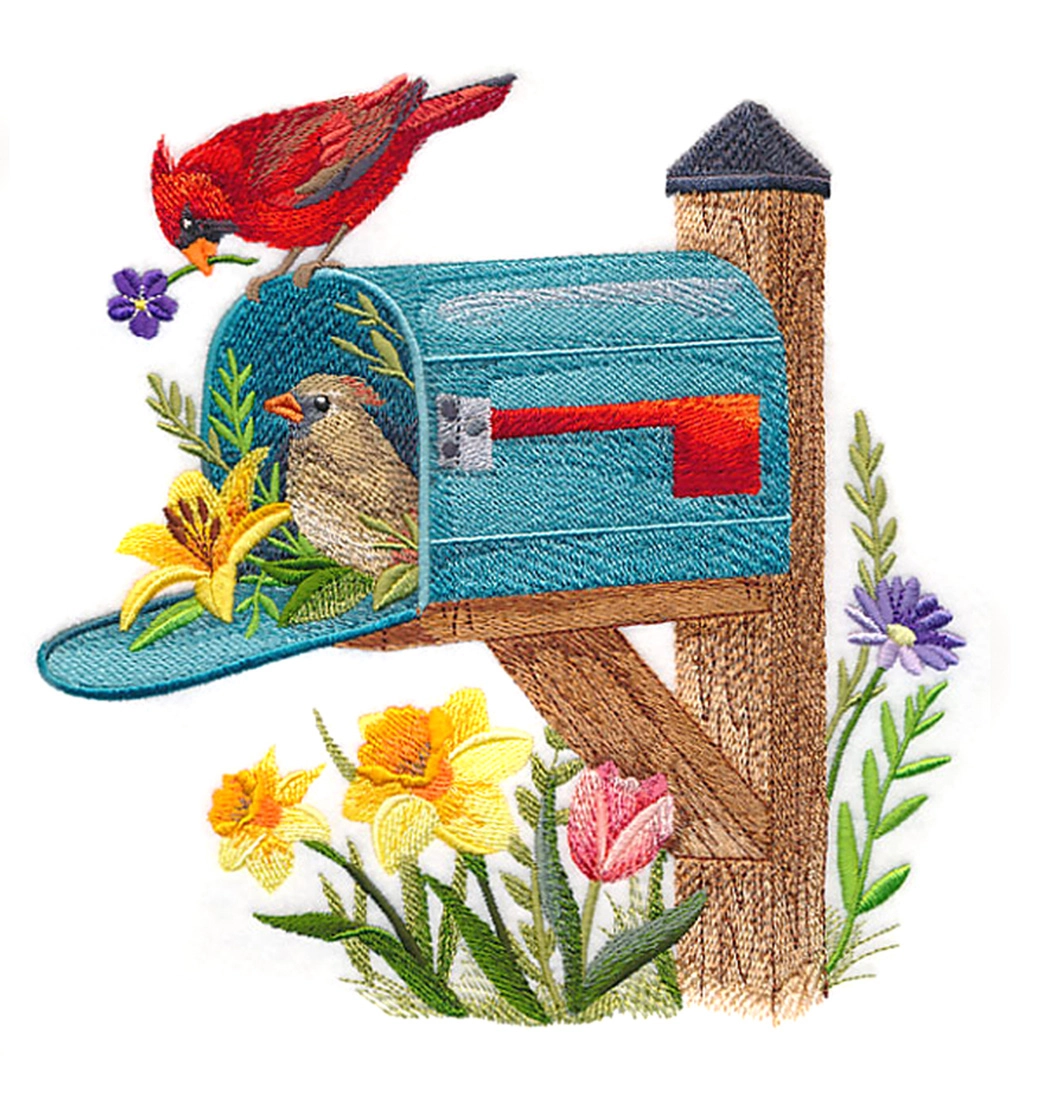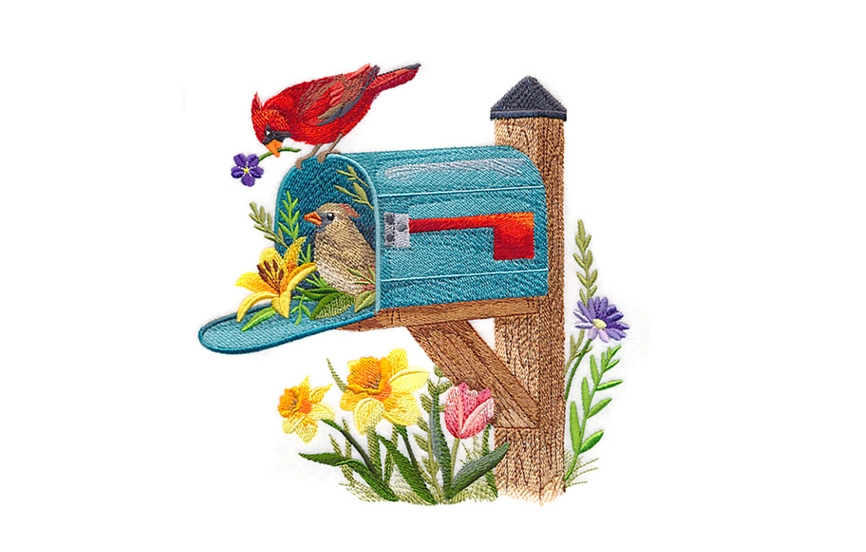Colorful and stylish, these placemats are sure to be a hit at your next fiesta.
Combine the classic sunflower quilt block with bright and sunny fabric and designs to make this stunning placemat.
Read below for these free project instructions and get started today!
May's sunflower fiesta placemat is the fifth installment of the Placemat of the Month series. Check back the first Wednesday of each month and you'll find a new placemat project, absolutely free for your use! Each project will demonstrate how to combine your love of embroidery with classic quilting methods.
Have you missed an installment? Links are below!
January - Snowball Block Placemat
February - Lots of Love Placemat
March - Patchwork Placemat & Patchwork Table Runner
April - Spring Pinwheel Placemat
June - Summertime Trapunto Placemat & Summertime Trapunto Table Runner
July - Crafty Cravings Placemat
August - Puppy Love Placemat
September - Autumn Abundance Placemat & Autumn Abundance Table Runner
October - Sumi-e Embroidered Placemat
November - Give Thanks Pocket Placemat
December - Rudolph's Run Placemat & Rudolph's Run Table Runner
Supplies
Supplies Needed:
**3/4 yard solid-colored quilter's cotton (for borders, pieced blocks, and back)
**Assorted fat quarters (we used 5 total) for embroidered and pieced blocks - one solid color and four prints
**Batting or extra-loft batting
**Medium-weight or lightweight cutaway stabilizer (we used Floriani No-Show Mesh)
Supplies Continued:
**Temporary spray adhesive
**Air-erase pen (or other marking tool)
**Straight edge
**Quilting cutting mat
**Rotary cutter
**Nylon monofilament thread
**Small piece of paper or tag board
**Needle and thread for some hand sewing
Designs used:
Mariposa - Small
Gallo - Small
These designs are also available in design packs:
A Traditional Talavera Design Pack - Large, Small
Finished Size:
19 1/2 inches wide by 13 1/2 inches high
Designs Used
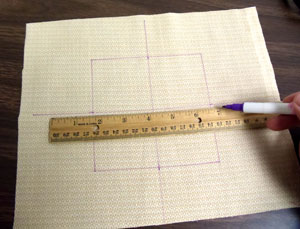
To begin, we will prepare the fabric for the embroidered blocks. Using an air-erase pen (or other marking tool), draw a 5 inch by 5 inch square on the print fabric - leave a couple of inches of excess fabric around the shape. Then, measure and mark the center of each side of the square by dividing by two. Draw lines to connect the marks. Where the lines meet is the exact center of the shape.
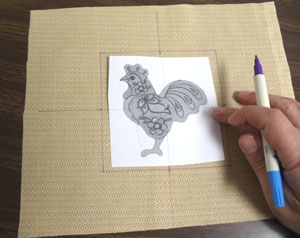
Create a paper template by printing the design at full size using embroidery software. If you don't have embroidery software, you can cut a piece of paper the shape and dimensions of the design to help with placement and centering. If you'd like a recommendation for an embroidery program that can make templates, consider Embird from www.Embird.com.
Poke a hole in the center of the template and align it with the center point on the fabric. Make sure the design fits well within the shape - there should be at least 3/4 inch of space between the outer edges of the design and the edges of the shape.
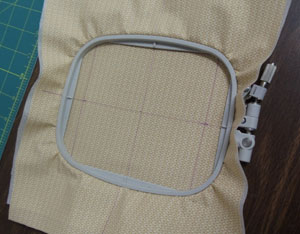
Spray a piece of medium-weight or lightweight cutaway stabilizer (we used Floriani No-Show Mesh) with temporary adhesive and smooth the fabric on top. Hoop the fabric and stabilizer together by aligning the marks on the hoop with the lines on the fabric. Attach the hoop to the machine and load the first design. Move the hoop so that the needle is aligned with the center point on the fabric. Embroider the design.

Repeat the fabric marking, hooping, and embroidering process for each embroidered block (we are embroidering four blocks). When the designs are finished, cut out the shapes.

To prepare the fabric pieces for the borders of the embroidered blocks, cut four pieces of the print fabric 3 3/4 inches wide by 1 3/4 inches high, for each block. Cut the pieces in half diagonally -- cut two of the pieces starting at the top left corner down to the bottom right corner, and cut the remaining two pieces at the top right corner down to the bottom left corner. For each block, also cut four pieces of the solid colored fabric 3 3/4 inches wide by 1 3/4 inches high. Cut them in half diagonally just as you did for the print fabric.
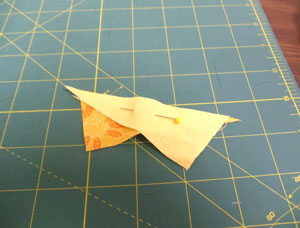
Pair up and align the print and solid pieces together, with right sides facing. The points should be opposite one another and extend out 1 inch past the edges of the fabric. Pin in place and sew a 1/4 inch seam along the long edge. Press the back seam open with an iron and trim off the excess fabric around the shape (together the pieces create a rectangle). Do this for each set of pieces.

Pair up and align two of the assembled rectangle shapes with the right sides facing. The short ends of the print fabric and seams should be aligned. Pin in place, sew a 1/4 inch seam along the short print ends only, and press the back seam.
Create a total of four separate assembled pieces per block -- these will be the border pieces.

Cut four 1 1/2 inch by 1 1/2 inch corner pieces of the solid colored fabric for each block. Take two of the assembled border pieces for each block, and align one corner piece at each end, with right sides facing. Pin in place, and sew a 1/4 inch seam along the ends only. Then, press the back seams.

Now, we'll assemble the embroidered blocks. Lay the embroidered piece right side up and align the border pieces (without the corners) along the side edges, right sides facing, with the solid colored edge facing out. Pin in place, sew a 1/4 inch seam along the outer side edges only, and press the seams.

Align the border pieces (with the corners) along the top and bottom edges of the assembled embroidered/side border piece, with right sides facing and the solid colored side facing out. Pin in place, sew a 1/4 inch seam along the top and bottom edges only, and press the seams.
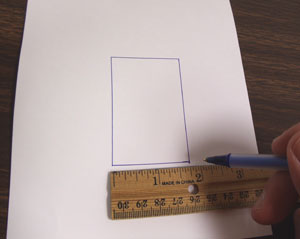
Next, we will prepare the fabric for the center non-embroidered blocks.
First, we will create a pattern for one of the shapes. On a small piece of paper or tag board, draw a 1 3/4 inch wide by 2 3/4 inch high rectangle.

Measure and mark one inch down along the left side of the shape, starting at the top left corner. Draw a line to connect the mark you just made, with the top right corner.

Cut out the shape following the diagonal line you just drew, the side lines, and the bottom line.

For each block (we are creating two blocks), prepare a total of eight pieces of print fabric by tracing the pattern and cutting out the shapes. Trace and cut four pieces using one side of the pattern, then, trace and cut four pieces by using the opposite side of the pattern.

For each block, cut four 2 1/4 inch by 2 1/4 inch pieces of the solid colored fabric. Cut the pieces in half diagonally.

Pair up and align the solid colored triangular pieces with the print pieces. The right sides should be facing, and the long edges of the triangles should be aligned with the diagonal edges of the print pieces.

Pin in place, sew a 1/4 inch seam along the pinned edge. Press the seam and trim off the excess fabric around the shape.

Pair up and align the assembled pieces together with right sides facing, and the solid colored edges and seams aligned. Pin in place and sew a 1/4 inch seam along the solid colored edges only. Press the seams.

Next, we'll assemble the top and bottom rows of the blocks. For each block, cut four 2 1/2 inch by 2 1/2 inch pieces of print fabric. Align the pieces on top of two of the assembled pieces (align with the print edges of the assembled pieces) with right sides facing. Pin in place and sew a 1/4 inch seam along the print sides only. Press the seams.

To assemble the middle row of the blocks, cut one 3 inch by 3 inch piece of print fabric for each block. Align the remaining assembled pieces on top, right sides facing, with the print edges of the assembled pieces facing out. Pin in place and sew a 1/4 inch seam along the print edges only. Press the seams.

Lay the assembled rows flat, with the right sides facing up and the print edges of the top and bottom rows facing towards the middle row.

Align the top row with the middle row, with right sides facing and seams aligned. Pin in place, and sew a 1/4 inch seam along the top edge only. Then, align the bottom row with the middle row, with right sides facing and seams aligned. Pin in place, and sew a 1/4 inch seam along the bottom edge only. Press the seams.

Now that all of the blocks are prepared, it is time to assemble the front panel.

Align the top left block with the bottom left block, with right sides facing and seams aligned. Pin in place along the top edge and sew a 1/4 inch seam along the pinned edge only. Press the back seam open.
Repeat this process with the top and bottom center blocks and the top and bottom right blocks.

Lay the center blocks flat and align the left blocks on top with the right sides facing. Align the seams, and pin in place along the left side. Sew a 1/4 inch seam along the pinned edge, and press the seams.

Align the right blocks on top of the center blocks with right sides facing. Align the seams, and pin in place along the right side. Sew a 1/4 inch seam along the pinned edge, and press the seams.

To prepare the fabric for the outer side borders, cut two pieces of fabric 1 1/2 inches wide by 12 3/4 inches high. Align the side pieces with the side edges of the assembled front panel, with right sides facing. Pin in place, and sew a 1/4 inch seam along the pinned edges. Then, press the seams.
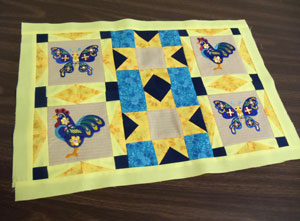
To prepare the fabric for the outer top and bottom borders, cut two pieces of fabric 20 1/2 inches wide by 1 1/2 inches high. Align the top and bottom pieces with the top and bottom edges of the assembled front panel, with right sides facing. Pin in place, and sew a 1/4 inch seam along the pinned edges. Then, press the seams.

To prepare the fabric for the back of the placemat, lay the assembled front panel on top of the fabric, pin in place, and cut out the shape. Also, cut a piece of the batting just as you did for the back.
Lay the back fabric flat with the right side facing up. Place the front panel on top, with right sides facing. Align the batting piece on top of the front panel and pin all the layers in place. Sew a 1/4 inch seam along the top, bottom, and one side edge -- leave the other side edge open for turning.

Turn the placemat right side out between the front and back panels (the batting will end up inside the placemat), and press the seams. Also, turn the fabric of the opening in 1/4 inch and press.

Hand-sew the opening closed by stitching with a needle and thread. With nylon monofilament in the needle, and matching thread in the bobbin (thread that matches the back fabric), quilt through all the layers by stitching along the existing seams of the front panel.

Your colorful creation is now complete!

